Lapidarium Stone Collection
Jerica Ziherl: Brief History of the Novigrad Lapidarium Museum’s Stone Collection
In the prestigious exhibition Croats and Carolingians, which after Split (in 2000) was also partially on display in Brescia (in 2001), the monuments from the Novigrad Lapidarium Museum occupied a prominent position, and the accompanying texts shed new light onto the city’s emergence.
Novigrad’s origin and the assumed, very early date of its establishment were frequently discussed in older historiography. The debate about the location of Emona, Emonija, Aemonia served the effort of ascertaining the establishment of the city in antiquity, which to date could not be corroborated by any material evidence, though such evidence could be found in the immediate city surroundings. Concrete, material evidence pertaining to the origin or the ‘political and economic’ status of the city lies in the preserved stone fragments from the Middle Ages and in the results of the most recent explorations of the Novigrad crypt. The increasingly commonly accepted thesis that the formation of Novigrad (and the Novigrad Diocese) is closely linked to the building of the crypt as part of the original architectural complex of the present-day St. Pelagius’ Parish Church, boldly transcends the centuries-old assumptions of the city’s Roman origins. What most contemporary authors dealing with the history of Novigrad wish to emphasize, is the undoubted existence of Novigrad as a Late-Antique castrum or castellum, i.e. a fortified civil settlement with defensive capabilities, which gradually developed into a city. This is also supported by the long-known fact that Novigrad was a centre of early Frankish rule and the seat of Duke Johannes (Dux Iohannes). Thus, the Lapidarium Museum’s stone fragments, above all those from the early Roman period, are of great importance for the Croatian, as well as for the European cultural heritage.
Although the Novigrad stone collection has long been well known among experts, who made it subject of their scientific explorations, it remained inappropriately (non-)exhibited for quite a while. In this case, the word inappropriately means simply not adequately and is not intended to be depreciative. Every period had its own notion of what is today understood by the musealization of cultural property. For this very reason the history of the Novigrad Lapidarium Museum takes us back almost a hundred years, which actually means that these precious monuments were as valued in the past as they are today. They were studied by Giacomo Filippo Tommasini (1595-1655, Bishop of Novigrad in 1641-1655), Pietro Kandler (1804-1872) and Giuseppe Caprin (1843-1904). These authors did not really write about a collection, but rather about singular stone fragments, which had ceased to be part of the sacral complex but still kept their artistic and cultural value. More detailed information about the collection can be found in the reports by the Istrian Society for Archaeology and Homeland History from Poreč, which also had two members from Novigrad, Giuseppe Parentin and Giovanni Urizo. In the report from 1895, for example, explorations in the Novigrad crypt are mentioned, which were conducted at the time in order to collect evidence in support of its assumed early Christian origin. But, instead of the sought-after floor mosaics, 23 stone fragments were discovered, mostly parts of parapets whose back sides had been used as flooring at earlier periods. Since their front sides were adorned with reliefs, it was decided to exhibit the fragments on the square, at the southern, lateral wall of the St. Pelagius’ Church (several other stone monuments had already been displayed there). The next relevant record pertains to the building of a new, adequate housing for the stone fragments. In 1897, the Novigrad commune established the Lapidarium Stone Collection and placed it in the loggia that stood on the main square, to the north-west of the St. Pelagius’ Church. It thus became part of the city’s Public Park. The construction of the Lapidarium building was supervised by Andrea Amoroso and Antonio Pogatschnig, and the overall cost of 1052.44 crowns was covered in equal parts by the Novigrad commune, the Istrian Society for Archaeology and Homeland History and the Austro-Hungarian Monarchy. The Lapidarium Stone Collection survived two world wars, but the small open-air museum was finally afflicted by the ravages of time and the lack of care. Branko Fučić, one of the first Croatian conservators who travelled to Istria after World War II, stated in his report from 1947 that he had found the collection in a dilapidated building (the loggia): […] inappropriately exhibited and inadequately protected, […] exposed to the elements, […] tastelessly dressed in concrete, […] the soft stone eroded by humidity and salt […]. After a pause of a number of years, it was decided that the collection should be moved to a more appripriate location and the loggia dismantled. Between 1962 and 1964 experts from the Istrian Archaeological Museum in Pula moved the collection to the ground floor of the Baroque Rigo Palace in the immediate vicinity of the main square, where it was documented and presented to the public. The Lapidarium Stone Collection thus became part of the medieval collection of the Pula museum, which curated the exhibits. But, in time, it once again became obvious that neither this location was entirely appropriate for the Lapidarium Stone Collection. The long-lasting influence of the elements had caused crumbling and disintegration of the stone, known in the conservators’ jargon as the stone plague, and the use of untreated iron brackets jeopardized the health of the stone and lead to fissures caused by rust; the same fixtures polluted the stone with cement, mortar and paint. Because of the collection’s alarming condition, as well as the humid and neglected premises it was kept in, consultations on its restoration were started in 1992 and 1993. In 1994 the long-lasting restoration of the Lapidarium commenced, conducted in a concerted effort by the Committee for the Protection of Cultural Monuments of the Novigrad Municipality, the Pula Archaeological Museum and, at the time, the Regional Cultural Monuments Preservation Office in Rijeka. The Lapidarium was once more disassembled and temporarily stored in the basement of the Novigrad primary school. The experts from the Archaeological Museum cleaned the exhibits and removed the iron brackets. In 1995, the Lapidarium restoration plan was drawn up and the desalination phase began. In the school basement three large basins were constructed, in which approximately 60% of the stone exhibits were immersed, while permanently monitoring the water quality. In 1996, under the supervision of conservator Ivo Donelli and the archaeologists and preparators from Pula, the basins were filled with fresh water and the remaining artefacts were immersed. The desalination was successfully completed in 1997, and in 1998 the structure of the stone exhibits was consolidated in a process of applying chemical substances to them (lasting 10 to 20 days per piece). Matching fragments were joined or reconstructed, and the documentation and the bibliography of the entire collection were produced.
Simultaneously with the restoration of the stone monuments, a project of the establishment and construction of a new museum for the stone collection was started. Since Novigrad had no appropriate historic space in which the Lapidarium stone collection could be exhibited, it was decided that the future museum was to be built in the city centre, as close as possible to the parish church, the former cathedral, from which most artefacts originated. The City Council chose a lot near the main square and the parish church, an empty, neglected surface inadequately used with regard to its size (sheds belonging to the tenants of nearby houses, parking lot, trash containers, etc.). In 1997, the Council set up the time frame for the foreseen activities and formed a working group entrusted with drawing up the programme of the establishment and the construction of Lapidarium Museum. In 1999, the changed and amended physical plan of the historic city centre was adopted, and in 2000 the museological plan was completed. The future construction site was determined based on the 2001 detailed urban development plan of part of the historic city centre. The 780 m2 large surface was to accommodate a rectangularly shaped building with an access ramp, and comprised part of the public park. Based on the established urban planning conditions, tenders were invited from select architects (Eligio Legović, Njirić + Njirić, Glivarec-Tajder and Randić-Turato). The participation conditions envisaged a fresh, innovative and technically mature concept that would provide a modern answer to the challenges of the museum programme and the urban context. Upon assessment of the submitted architectonic designs, the project Two Black Boxes and a Park by Rijeka architects Randić-Turato was selected for implementation. This choice was substantiated by the conclusion that the structure of the future museum with its focussed and austere form — a simple tectonic frame dominated by two black boxes serving the purpose of exhibiting the collection — reflected the reciprocal relation between the physical presence of the building housing the artefacts and its surroundings. The project represented neither a neutral white cube nor a spectacular sculptural manifesto. It was concluded that it fulfilled the form of tangible tension between constructional necessity, spiritual value and experiential articulation. Finally, the selected project was found to constitute a successful interpolation of modern architecture into the historic city core and a framework worthy of the valuable exhibits. In 2003, the required documentation was put together, and the following year, after an archaeological exploration of the site, the construction works began. In 2006, the new museological plan was executed and the stone collection was housed in the new building, i.e. in the newly-founded public cultural institution called the Lapidarium Museum.
We have reached the end of our story about Novigrad’s valuable monuments. As stated initially, every period has its own notion of the musealization of cultural goods. In our time, the museum should act as an energy tank, with a potential to also include new pictorial complexes, concepts and constructs in the creation of a place where a credible story is told. Thus, the Novigrad museum is compact on the one hand and polyvalent on the other; it is a modern urban hybrid, whose purpose is not only to present an exhibition in a traditional manner but also to present an identity. To present human construction and not human destruction, on might add.
It is very likely that the Museum will have a positive effect in every way, growing into one with its surroundings, revitalising the existing situation with its lively content and becoming a place frequently visited by the citizens of Novigrad and their guests. But the Lapidarium Museum will above all bear witness to the rich cultural and historical heritage belonging not only to the place of its origin: the intertwined mutual relations and influences make it part of European cultural events. Finally, it will also bear witness to the identity of Novigrad, which well aware of its past, strives to preserve its values and its meaning for the generations to come.

Grave stela with two portraits. Inscription: F(austa) / HOSTILIAE C. F. FAUSTAE / HOSTILIA C. F. QUARTA / SORORI. V(iva) F (ecit). 1st century, limestone, 93 x 63 x 24 cm.
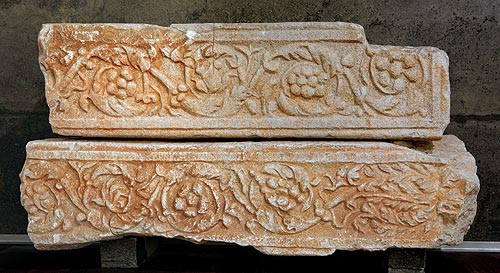
Two gravestone fragments, the front sides decorated with naturalistic vine. 1st century, limestone, 29 x 108; 30 x 123 x 45 cm.
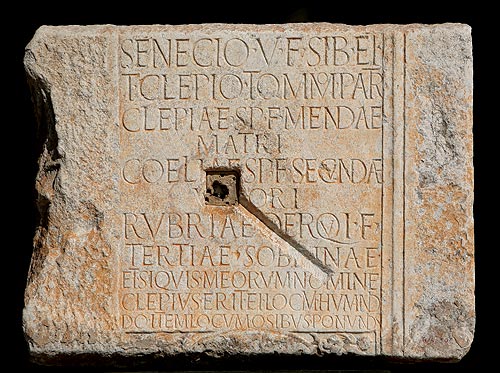
Gravestone with inscription, sides decorated with vine relief. Missing is the top line of the inscription, which is partly preserved on a fragment found in the cathedral crypt. The full inscription reads: C. CLEPIVS T. F. PVP(inia) / SENECIO V(ivus) F(ecit) SIB (i) ET / T. CLEPIO TOMMO PATR(i) / CLEPIAE SP(ecatbili) F(eminae) MENDAE / MATRI / COELIAE SP(ectabili) F(eminae) SECUNDAE / RVBRIAE QUEROVI F. / TERITAE SOBRINAE / ET SI QVIS MEORUM NOMINE / CLEPIUS ERIT EI LOCVM HUMANDI DO ITEM LOCVM OS(s)IBVS PONVDIS. 1st – 2nd century, limestone, 85 x 58 x 28 cm.
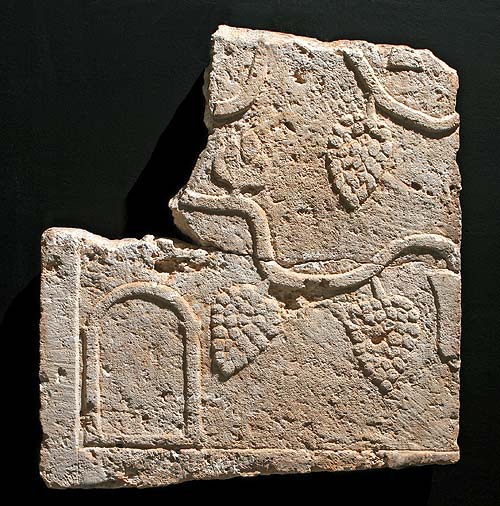
Fragment of a tablet decorated with vines and grapes. 4th – 5th century, limestone, 53 x 48 x 7 cm.
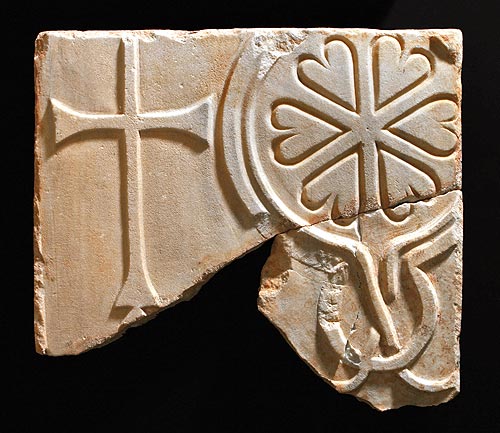
Fragment of a coating panel with the Monogram of Christ in medallion between crosses. 6th century, marble, 53 x 59 x 4 cm.
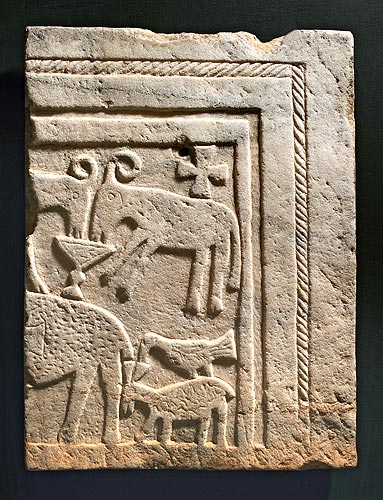
Right part of an altar divider parapet with reliefs of symbolic animals. 8th century, limestone, 83 x 72 x 4 cm.
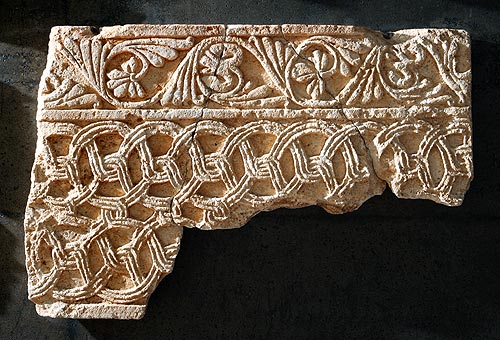
Bishop Mauritius Ciborium, late 8th century, limestone. The hexagonal ciborium stood in the baptistery of Novigrad cathedral. The arrangement of the ciborium sides is determined by the inscription running along them just below the cornice. The inscription is incomplete. Interpretation according to G. Cuscito: HOC TIGMEN LUCEFLUO ALMOQOE / BAPTISTERIO DIGNO MARMORE (ERECTUM?) / MAURICIUS EPISCOP(US) O (BT)ULIDEO SUMMO / E STUDIO DEVOTE PECTORE TOTO. BEATE IOHANIS / (…) ERRE SE DELEARIS PLURA NOSTRA CRIMINA.
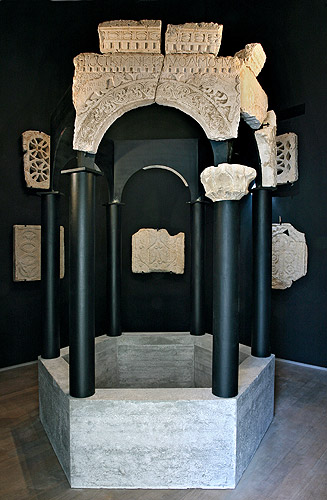
A replica of the former baptistery in the Novigrad cathedral with the Bishop Mauritius Ciborium, 8th century.
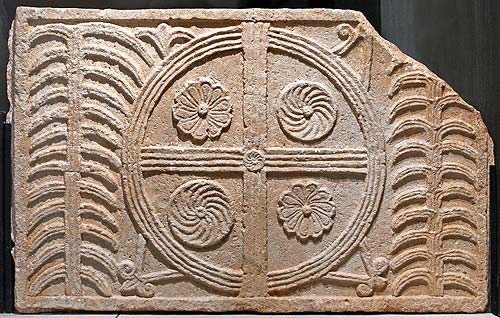
Decorated parapet of an altar divider. 8th century, limestone, 90 x 141 x 8 cm.
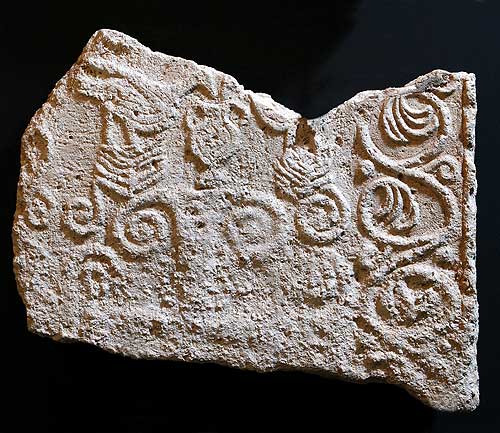
Fragment of a tablet with an entwined cross relief. Above the cross two doves drinking from a chalice. 8th century, limestone, 42 x 52 x 6 cm.
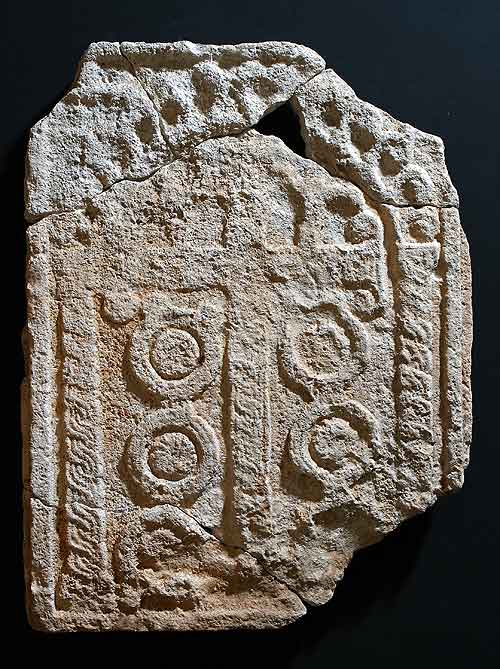
Parapet of an altar divider with a motif of a cross decked with foliage under an arch symbolizing paradise. 8th century, limestone, 88 x 59 x 7 cm.
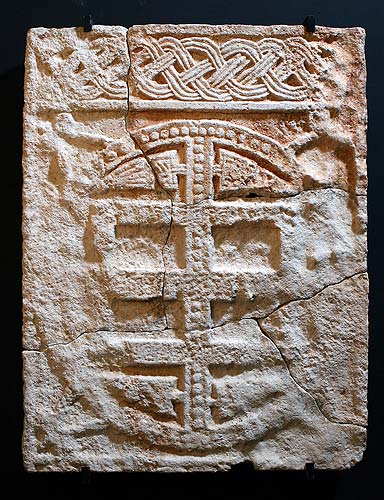
Parapet of an altar divider. The frieze is decorated with three-strand interlacery, and the field showcases a triple cross decked with foliage, encircled by a string of small spheres. 8th century, limestone, 112 x 88 x 8 cm.
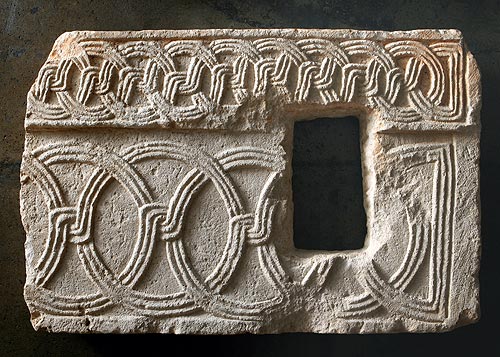
Parapet of an alter divider. Frieze decorated with interlacing circles. Large interlacing circles in the field below. Late 8th – 9th century, limestone, 63 x 96 x 110 cm.
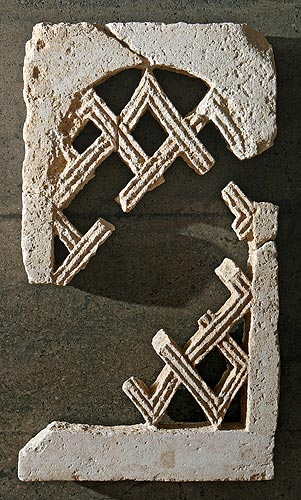
Openwork window panel with diagonally interlacing grille. 8th – 9th century; limestone, 108 x 57 x 20 cm.
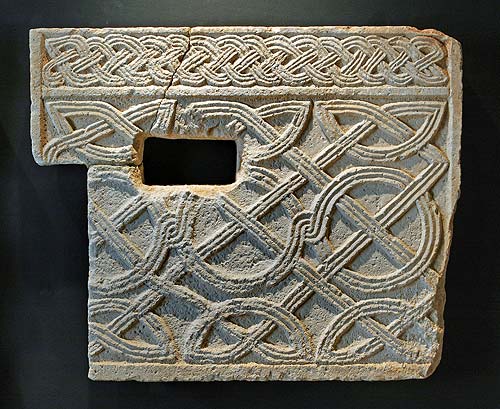
Parapet of an altar divider. With three-strand interlacery on the frieze and diagonally in the field below. 8th – 9th century, limestone, 92 x 115 x 8 cm.
Two trapezoidal tablets decorated with three-strand interlacery ornamentation. Presumably roof fragments of a ciborium. 8th – 9th century; limestone, 165 x 50/30 x 8;125 x 59/32 x 8 cm.
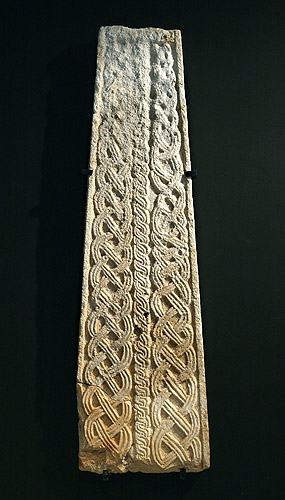
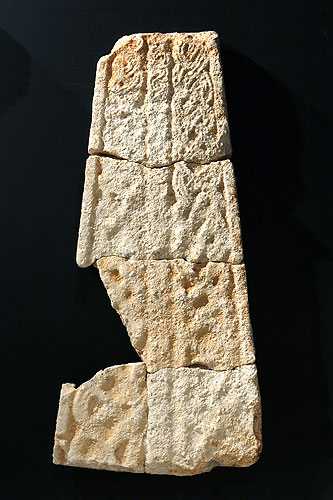
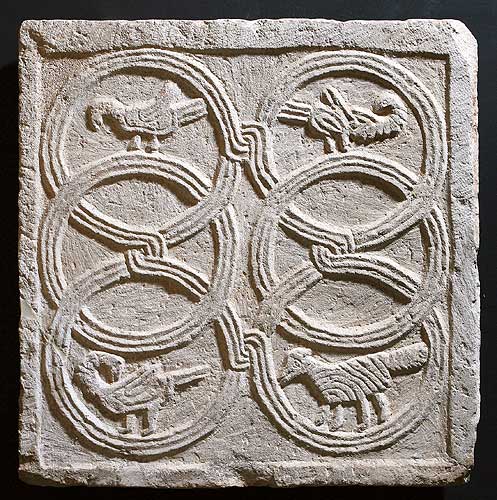
Pilaster of an altar divider with intersecting circles in the capital area and a double-framed coffer-like panel in the field. 8th – 9th century; limestone, 98 x 35 x 12 cm.
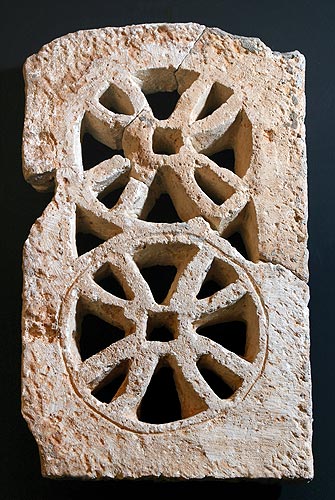
Tablet decorated with two arrays of interlacing and intersecting circles, featuring three birds and a lamb in the corners. 8th – 9th century; limestone, 74 x 74 x 9 cm.
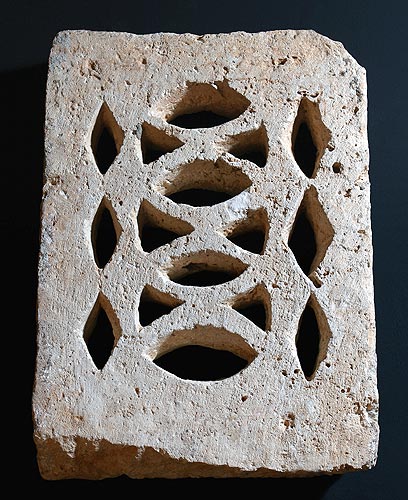
Openwork window panel with a grille formed by two perforated circles with radial spokes. 8th – 9th century, limestone, 105 x 59 x 9 cm.
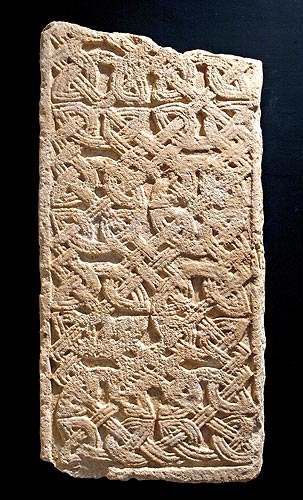
Openwork window panel with a grille formed by intersecting circles. 8th – 9th century, limestone, 108 x 57 x 9 cm.

Tablet from an altar divider, decorated with a dense mesh of circles interlaced with diagonal bands. 8th – 9th century, limestone, 114 x 54 x 10 cm.
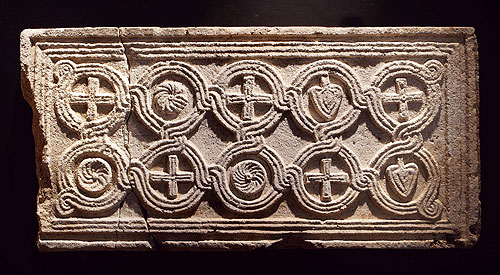
Parapet of an altar divider with a relief of two rows of interlaced circles with crosses, rosettes and leaves at their centres. 8th – 9th century, limestone, 72 x 153 x 10 cm.
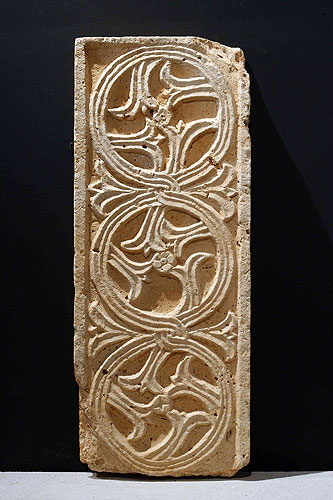
Pilaster of an altar divider featuring a row of three large interlaced circles with slanted lilies of their centres. 8th – 9th century, limestone, 113 x 45 x 11 cm.
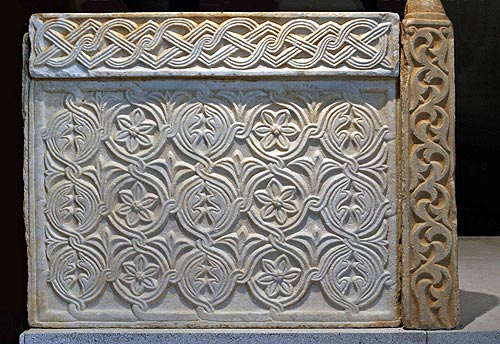
Pilaster of an altar divider with vertical, intermittent vine. 9th century, marble, 16 x 97 x 10 cm.
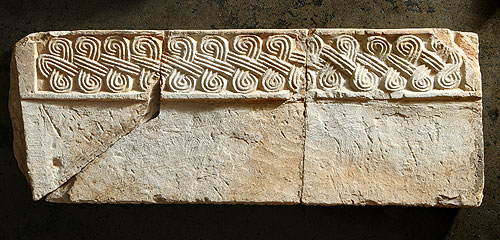
Fragment of the upper part of an altar divider parapet, its frieze decorated with three-strand interlacery. 9th century, limestone, 42 x 118 x 8 cm.
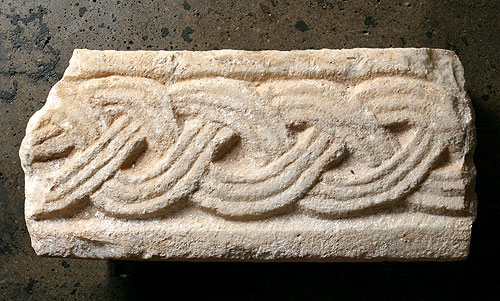
Fragment of a cornice decorated with three-strand interlacery. 9th century, limestone, 19 x 41 x 10 cm.
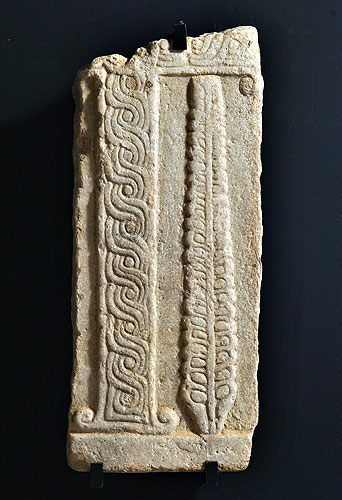
Fragment of a tablet with a tree-strand interlacery ornament. 9th century, marble, 98 x 26 x 12 cm.
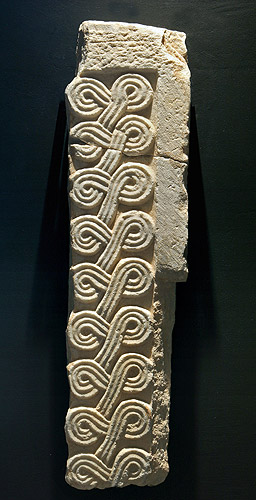
Parapet of an alter divider. The frieze features three arched semi-flowers, the field below two vertical columns of diagonally intersected interlacing circles. 9th century, marble, 113 x 82 x 11 cm.
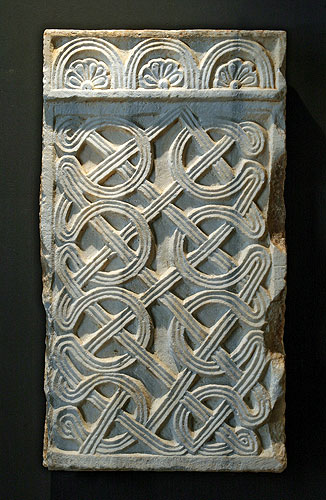
Fragment of the upper part of a decorated tablet, probably a parapet pf an altar divider. The frieze with a single-strand interlacery ornamentation and the field showing lions and griffins in rectangular coffers. 11th – 12th century, limestone, 67 x 87 x 8 cm.
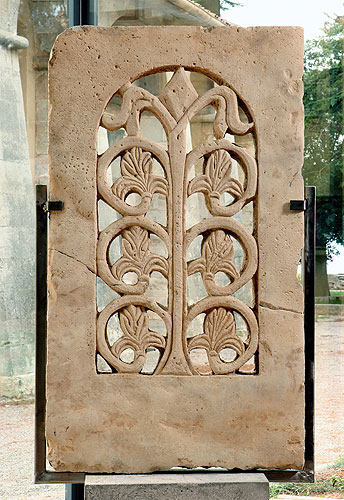
Openwork window panel with a symetrical, double vine in full leaf. 11th – 12th century, limestone, 114 x 67 x 11 cm.
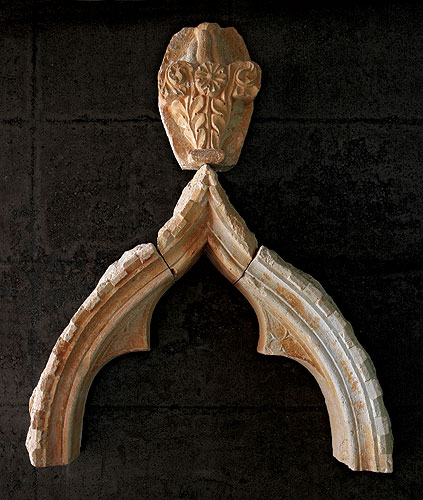
Fragments of a window frame with a pointed arch and akroteria. 15th century, limestone, 136 x 80 x 18 cm.